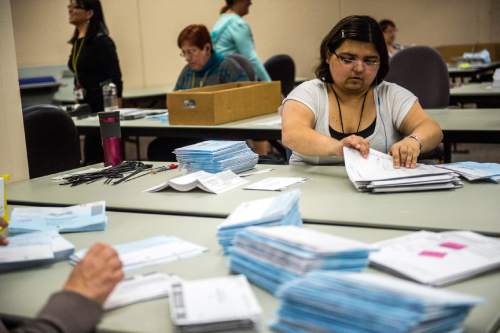This is an archived article that was published on sltrib.com in 2015, and information in the article may be outdated. It is provided only for personal research purposes and may not be reprinted.
Utah cities and counties that voted by mail this year increased voter turnout by an average of 52 percent, a new study says.
That is welcome news because turnout has plummeted in recent decades, including setting a record low in 2014, when only 28.8 percent of the state's voting-age population participated in the general election, according to the Utah Foundation.
It released a report Wednesday looking at some of the reasons for low voter turnout and methods that could boost it.
Atop the list of actions bringing improvement so far is voting by mail.
The report said that all of the 70 Utah cities that chose to vote by mail this year increased turnout compared with the two previous municipal elections, in 2013 and 2011.
"Smaller communities saw higher turnout than larger cities," the report said, "and average turnout for the participating cities was 40 percent," an improvement of 52 percent from the previous election.
For example in Salt Lake City, which had a close mayoral election, canvass results show turnout was 54.6 percent — up from 13 percent in 2013 and 24 percent in 2011. The mayoral election in the capital four years ago was far less competitive.
Some other vote-by-mail cities with the highest turnout were: Wallsburg, 68 percent (no election was held there two years ago when it "forgot to hold the municipal election" when no candidates filed); Green River, 65 percent (up from 35 percent); Moab, 62 percent (up from 16 percent); and Charleston, 61 percent.
The report notes that voting by mail "removes obstacles created by getting to the polls and finding time to vote when locations are open for limited hours." It said Utah also helped overcome those problems with "early voting" in weeks before Election Day.
The report said studies have found that reasons for decreasing voter turnout in Utah range from having fewer competitive races to obstacles that make it difficult to vote or register.
"A lack of competitive races has been increasing in statewide and federal races while turnout has been decreasing. In the past decade the majority of races have either been won by a significant margin (30 percent or above) or have lacked an opponent," the report said. "This lack of competitive races is at least partially due to Utah's [historic] caucus-convention system."
Until the system was changed recently, delegates selected a party nominee if a candidate won more than 60 percent of votes at convention. Otherwise, delegates narrowed the field for a primary to the top two candidates.
Because Utah has large Republican majorities, the caucus-convention system often took the real contest — between GOP rivals — out of voters' hands. So a group called Count My Vote started a petition drive to replace that system with a direct primary. But the Legislature passed SB54 in 2014 as a compromise, allowing candidates to qualify for a primary either through the traditional caucus-convention system or by gathering enough signatures.
Despite court challenges to SB54 by the Republican and Constitution parties, the 2016 election will be the first time the new system will be used. "So the actual impact on civic engagement and voter participation are yet to be seen," the report said.
Hurdles to voter registration are a problem despite improvements, the report said. It notes that Utah Foundation research has shown that while 90 percent of Utahns believe they are registered, only about 63 percent are. Part of the problem, the report said, is that some people mistakenly think that if they report an address change to the Division of Motor Vehicles, that will automatically change their voter registrations. It does not.
Utah has taken steps to make registration easier, the report said, including allowing online voter registration for people who have a signature on file with the Division of Motor Vehicles; allowing 16- and 17-year-olds to "preregister" to vote when they obtain a driver license, effective when they turn 18; and an experiment with Election Day registration in some counties.



